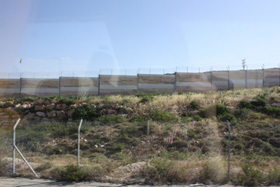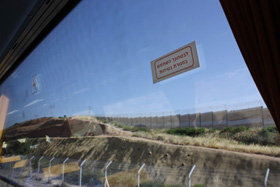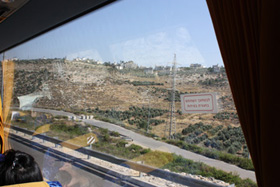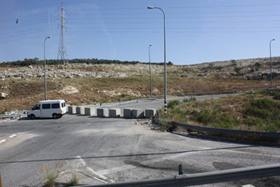
|
Breakfast at a table with H.B.III, K.P., D.M., and H.K.
The highway 443 that we traveled on to reach Jaffa has been off limits to Palestinian traffic since 2001. To Israelis on this side of the highway, the “security wall” is a short wall with a red-and-white sandwich pattern instead of the drab, grey affair we were used to seeing by now. Bedouin village ruins litter the side of the highway. A Israeli Supreme Court decision ruled the ban on Palestinian traffic illegal and demanded the removal of roadblocks, but the state of Israel has refused to comply. We saw that concrete roadblocks installed on Palestinian roads to block their access of highway 443 remained in place. “How can Palestinians use the highway when the blocks are there? It was all a lie,” remarked our guide. Furthermore, the number of temporary checkpoints along the highway have also increased. There were no green or white Palestinian license plates visible on the highway for the duration of our drive towards Jaffa.




Sami Abou Shada, a Palestinian doctoral candidate writing his dissertation on Jaffa’s history, gave us a walking tour through Jaffa.
In the past, Jaffa was one of the holy places to Christianity and served as host to 100,000 tourists each year. Christians around the world would make a pilgrimage at least once in their lifetime to Jaffa, and the average stay was 1 year to 18 months.
Jaffa used to be a because its soil is very fertile, its elevated position is advantageous, plus the distance to Haifa and to Gaza was 90 kilometers in each direction. Jaffa was the main port of Palestine. It used to export 5 million crates of Jaffa oranges. With that volume of export, there was naturally a huge demand for labor in all levels of the supply chain — you needed people to cultivate, to harvest, to make the paper that wrapped the oranges, to assemble the boxes that held the oranges, to load oranges onto ships. Laborers from all over the middle east came to Jaffa. After Jaffa was seized, the orange groves were destroyed, the port closed, and the brand name Jaffa Oranges was sold off to Spain and South America.
In 1936, Palestinians in Jaffa staged the most successful, continuous 6-month strike ever seen in the world. In 1939, England released the White Paper that outlined these terms: 1. Establish the country of Palestine; 2. stem the flow of unchecked Jewish immigration to Palestine Mandate; 3. limit the sale of land to Jews. They were designed to soothe restless concerns regarding England’s promise to Palestinian self-determination.
In the year 1936–1939, after the Palestinian revolt, the English executed what was dubbed the “Anchor Plan,” so called because the old city was blown up with dynamite from the left, right, and middle.
Jaffa was considered the jewel of the Arab world, and once pushed forth as a candidate for the olympics due to its accessibility. 1948 would change all that.
Before the war of 1948, the population of Jaffa was 120,000; after the war, only 4,000 remained. Arabs were forcibly relocated to the neighborhood of Ajami, where they were fenced and surrounded by fierce dogs in ghettos. Individuals that had contact with family or relatives fleeing to other Arab countries were considered enemies. Most of the Palestinian villages were under military control well into the 1960’s.
In 1948, there were 600,000 Jews, of which 100,000 were soldiers — 1 in 6. The Arab soldiers numbered 30,000. Disaster would visit Palestinians in 3 major phases: 1. The disposession of Palestinian land and Palestinians fleeing conflict to become refugees in the diaspora came to be known as the Nakba, first coined in the book “The meaning of the Nakba.” 2. Knesset sanctioned the absentee law, a legal means to dispossess Palestinians of their properties. Refugees in the diaspora outside of Israel could not return, and so their land were confiscated by the state. Refugees in Ajami could not return to the homes and land that they fled from, so they too were dispossessed of their property. Even if you were living on your land or in your home, you could still be considered absent if you were absent at the time of counting, so you could be absent even when present. 3. Apartments in Ajami would be divided to house new Jewish immigrants, and Palestinians had no say in the matter. In the 1950’s, the inability of Jaffa’s men to protect their family and property greatly demoralized them; over 50% became afflicted with deep depression and turned to substance abuse, crime.
Since Israel’s inception, arists and academics had collaborated closely with Zionists. Archaeologists would conduct digs to find traces of Jewish heritage. Where there were none to be found, they would destroy. 50% of the Palestinians refugees in the diaspora were from Jaffa.
In the 1960’s, the city put forth a plan to reform the neighborhood of Ajami into a Riviera. This was met with widespread opposition but it proceeded anyways by destroying 3,000 apartments, discarded trash onto the beach, buried the demolished apartments. The collection of trash became hazards, periodically would combust, arresting plans for redevelopment after a supreme court decision. Now, the neighborhood of Ajami is under another threat of redevelopment. There is a gated community being developed that is off limits to Arabs. Israeli Jews who have close relationships with the Palestinians tried to buy these property and were rebuffed with the explanation that only religious Jews are allowed to buy property in the development.
Had lunch at a Palestinian restaurant in the neighborhood of Ajami. Had a wonderful dish that L.E. described as a Palestinian pizza topped with sauteed vegetables and chicken.
Passed the statue of Theodore Herzl, the father of Zionism.
We met New Profile at the Kibbutz Haogen. The presentation was on the militarization of Israel. The militarization of Israeli society permeated everything, including advertisements, schools, playgrounds, military bases, even a day of costume dress up similar to our Halloween. The membership of New Profile is against militarism. Israel controls everything from Jordan to the sea.